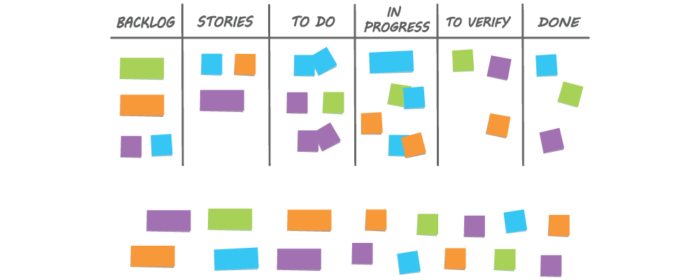Agile Methodologies: Scrum Sprints vs. Kanban Boards
Agile methodologies offer a collection of frameworks designed to improve software development processes. They emphasize flexibility, collaboration, and iterative progress. Key principles focus on responding to change effectively and delivering value quickly. Central to these methodologies are different approaches, like Scrum and Kanban, which offer distinct ways to manage projects and tasks. Understanding these differences allows teams to select the most appropriate framework for a given project. This article provides a comparative overview of Scrum sprints and Kanban boards, highlighting their strengths and weaknesses and guiding readers on selecting the right approach for “sprints vs kanban” projects.
Scrum and Kanban are two popular Agile frameworks. Scrum typically utilizes time-boxed iterations known as sprints. Kanban, conversely, emphasizes a workflow approach without fixed time constraints. Each method offers a unique set of tools and practices to structure development. The effectiveness of each relies on understanding their differing applications. Careful consideration of team structure and project requirements is critical when selecting a method for managing “sprints vs kanban” projects.
A key differentiator lies in their approach to project management. Scrum, with its defined sprints, often suits projects requiring predictability, clear goals, and frequent releases. Conversely, Kanban, with its continuous workflow, is well-suited to projects with evolving requirements and a need for flexibility. Proper implementation and understanding of “sprints vs kanban” concepts are essential to optimize productivity and maintain project momentum.
Scrum Sprints: Time-boxed Iterations
Scrum sprints are time-boxed iterations, a fundamental concept in agile methodologies. These defined timeframes are crucial for managing the software development lifecycle. Each sprint typically lasts one to four weeks, offering a structured approach to development. This structured approach allows teams to focus on delivering increments of value within each time-boxed iteration. The sprint cycle is divided into various stages, each serving a specific purpose. These iterative cycles help teams develop and deliver valuable products rapidly.
The sprint cycle includes distinct phases: sprint planning, daily stand-ups, sprint review, and sprint retrospective. Sprint planning involves outlining the work to be completed in the current sprint, defining tasks and their estimated time requirements. Daily stand-ups are short meetings where team members synchronize their work, identify impediments, and resolve any roadblocks. The sprint review is a demonstration of the work accomplished in the sprint, providing stakeholders with a tangible overview of the progress. Lastly, the sprint retrospective is a crucial session dedicated to improving the team’s process. This self-reflection and continuous improvement are vital components of Scrum.
Consider a software development project building a mobile application. A team might plan a sprint to develop the user interface for the application’s primary features. Daily stand-ups would be used to track progress on the tasks, discuss any issues, and ensure everyone is on the same page. A sprint review would allow stakeholders to see the developed user interface and provide feedback. The retrospective would look into ways to improve the efficiency and effectiveness of the team’s development process in subsequent sprints, streamlining future development efforts. Understanding these sprint vs kanban methodologies is key to successful project management.
Kanban Boards: Visual Workflow
Kanban boards provide a visual representation of workflow. They use a continuous flow model, unlike time-boxed iterations like sprints in Scrum. The visual nature of a Kanban board makes it a powerful tool for tracking progress and identifying bottlenecks in software development processes. This approach allows teams to adjust to changing demands, a crucial advantage in modern software development. Agile sprints vs kanban boards offer various options in the methodology for development.
A core element of a Kanban board is its visual layout. The board typically includes columns representing different stages of the workflow, such as “To Do,” “In Progress,” and “Done.” Individual work items, often represented by cards, are moved through these columns as they progress. This system allows the team to track the movement of work and readily identify any areas needing attention, like possible roadblocks or bottlenecks in the development process. Kanban helps understand the development process for sprints vs kanban methodologies.
The flexibility of Kanban is a significant advantage. Teams can easily adapt to changing priorities and workloads. Cards can be added to the board at any time, and the workflow can be adjusted without needing to start a new cycle. This adaptability is essential for projects with evolving requirements and for improving responsiveness to shifting priorities. Understanding the workflow of sprints vs kanban methodology ensures optimal project management. Using a visual tool like a Kanban board can enhance workflow and improve progress of development and delivery of projects. This enhances collaboration and ensures projects are successfully managed through an Agile approach.
Comparing Scrum Sprints and Kanban Boards
Choosing between Scrum sprints and Kanban boards for software development hinges on the nature of the project and team dynamics. A key distinction lies in the approach to workflow. Scrum sprints use time-boxed iterations, while Kanban fosters a continuous workflow. Understanding these differences is crucial for project success. This section explores the essential differences between these agile methodologies, focusing on sprints vs kanban.
Scrum’s time-boxed sprints offer structure. They define specific timeframes for completing tasks. This structured approach can be advantageous for projects with clear objectives and frequent releases. On the other hand, Kanban, emphasizing visual workflow, provides more flexibility. Teams adapt easily to shifting requirements. This flexibility can be beneficial for projects where demands change rapidly. When assessing sprints vs kanban, consider the project’s complexity. A complex, dynamic project might benefit from the controlled iterations of Scrum, while a simpler project may find Kanban’s continuous flow more appropriate.
The table below illustrates a comparison of key features:
| Feature | Scrum Sprints | Kanban Boards |
|---|---|---|
| Iteration Length | Fixed, time-boxed sprints | Continuous flow |
| Workflow | Structured, with phases like sprint planning and reviews | Visual, using a workflow representation |
| Team Structure | Self-organizing teams | Cross-functional teams, potential for diverse roles |
| Project Suitability | Well-defined, frequently released projects | Projects with unpredictable requirements, or continuous delivery |
This comparison provides a basic framework. Factors like team size, project complexity, and the desired level of control over workflow play significant roles in the final choice between Scrum sprints and Kanban boards. Proper selection is crucial for effective project management. Consider the intricacies of sprints vs kanban to make an informed decision.
When to Choose Scrum Sprints
Scrum sprints excel in projects possessing well-defined goals, requiring frequent releases, and demanding strict time management. This structured approach offers a valuable framework for projects with clearly outlined deliverables. In app development, where new features are often released incrementally, sprints prove highly effective. A web development project with a predetermined schedule and regular milestones also aligns well with the sprint structure. Sprints provide a structured path to deliver features on time, ensuring project completion within the pre-defined timeframe. The iterative nature of Scrum sprints lends itself to adaptability and flexibility in responding to changes, allowing for quicker adjustments compared to traditional waterfall approaches. This approach to project management and sprints vs kanban is particularly useful when predictable outcomes are expected and the project is expected to stay on track.
The iterative nature of sprints allows teams to review progress and make necessary adjustments in shorter, manageable cycles. Frequent reviews facilitate early identification of potential issues, mitigating risks and enabling rapid course correction. For teams handling complex features or those that evolve rapidly, the iterative nature of Scrum sprints aids in maintaining control and flexibility. In software development, where requirements often change, sprints provide a framework to accommodate these adjustments and ensure the final product meets current needs. Scrum sprints can thus help in managing projects in complex environments where priorities shift, ensuring all changes are reflected in the product incrementally.
Furthermore, the sprint structure provides the team with a clearer vision for each cycle. It establishes a framework to deliver a completed product increment at the end of each sprint. When the project requires a highly motivated and focused team for each cycle, sprints vs kanban can be a significant advantage. The structure and clear objectives of sprints help foster this environment and maintain a consistent pace. Teams that understand the structure and rhythm of sprints find it easier to manage the complexity of software development tasks. This structured framework is particularly advantageous for managing projects with specific deliverables that must be met during each iteration.
When to Choose Kanban Boards
Kanban boards are often the preferred approach for projects with unpredictable requirements and a need for flexibility. This agility is especially valuable in situations where continuous delivery of small features is crucial. For instance, in customer support environments, swift responses to evolving customer needs are vital. Kanban’s adaptability allows teams to adjust to changing priorities seamlessly, making it a superior choice compared to the rigidly structured sprints vs kanban for these cases.
Consider projects where features are not precisely defined upfront. A marketing campaign, for example, may require constant adjustments based on consumer responses. The iterative, adaptive nature of Kanban enables teams to respond effectively to these dynamic shifts. This real-time adjustment capability is a significant advantage of Kanban over sprints vs kanban in such instances, allowing the team to remain agile and reactive to changing market conditions.
Furthermore, Kanban excels in environments demanding continuous delivery. In software development, a steady stream of small improvements and bug fixes can be implemented more effectively using Kanban’s continuous flow model. This continuous evolution can lead to greater customer satisfaction and reduced turnaround times for resolving issues. In conclusion, choosing Kanban for projects with evolving needs, adaptability, and a focus on continuous delivery is the preferred approach over rigid sprints vs kanban methodologies.
A Practical Guide to Choosing the Right Approach for Sprints vs Kanban
Selecting the optimal Agile methodology – Scrum sprints or Kanban boards – hinges on careful consideration of project specifics. Understanding the nuances of each approach allows for informed decisions that maximize efficiency and effectiveness. This guide offers a step-by-step approach to choosing the right methodology for your specific project needs.
First, meticulously analyze the project scope. Projects with well-defined goals and deliverables frequently benefit from the structured iterations of Scrum sprints. Conversely, projects with evolving requirements or continuous delivery needs may be better suited to the flexibility of Kanban boards. Assess the team’s size and experience; smaller teams might find the streamlined structure of Kanban more manageable, while larger teams with complex projects might find the structured sprints more effective. Consider the team’s existing workflow and processes; seamlessly integrating a new methodology often hinges on adapting existing workflows.
Furthermore, evaluate the desired level of control over the workflow. Scrum’s time-boxed sprints offer a higher degree of control and predictability, while Kanban’s continuous flow model provides more flexibility. Consider the frequency of releases needed; projects with frequent releases often find Scrum sprints advantageous. Projects requiring swift adaptation to changing circumstances may lean toward the more adaptable Kanban approach. By thoroughly considering these crucial factors, organizations can select the ideal methodology for their specific circumstances, effectively managing sprints vs kanban. Understanding these elements will enable a successful methodology adoption and improve productivity in project delivery.
How to Implement Kanban Effectively
Implementing a Kanban system effectively requires a structured approach. Begin by setting up a visual Kanban board. This board will serve as the central hub for tracking progress and visualizing workflow. Choose a clear and easily understandable representation, such as sticky notes or digital tools. The board should display workflow stages as columns (e.g., “To Do,” “In Progress,” “Testing,” “Done”). Visualizing the workflow through cards and columns provides a clear perspective on the “sprints vs kanban” processes.
Once the board is established, select suitable metrics to track progress. Key metrics might include cycle time (the time it takes for a task to move through the entire workflow), throughput (the number of tasks completed in a set time period), and lead time (the time between the initiation of a task and its completion). Regularly monitoring and analyzing these metrics provides valuable insights, enabling teams to identify bottlenecks, optimize workflows, and fine-tune the “sprints vs kanban” strategies. Regular analysis of the Kanban board fosters a continuous improvement culture.
Foster a culture of continuous improvement within the team. Encourage feedback and collaboration among team members. Establish mechanisms for regularly reviewing the Kanban board and making necessary adjustments. Encourage team members to identify bottlenecks, suggest improvements, and actively participate in optimization efforts. This approach will yield high returns on investment in implementing a “sprints vs kanban” system. Regularly review and refine the Kanban workflow to reflect evolving needs and priorities. Team collaboration and feedback are key to maintaining a smooth and efficient workflow. Using a “sprints vs kanban” approach can increase team effectiveness.



